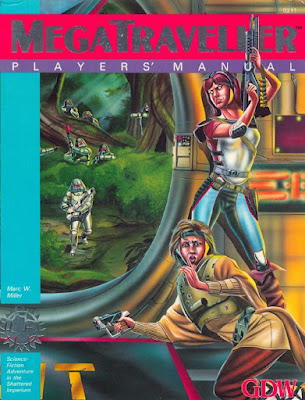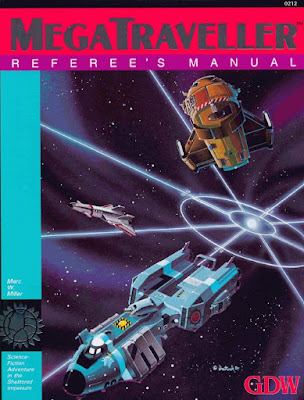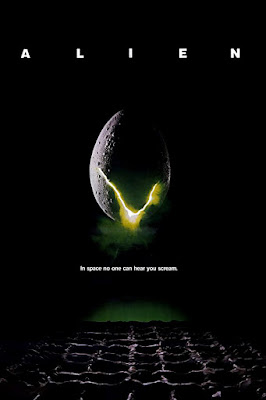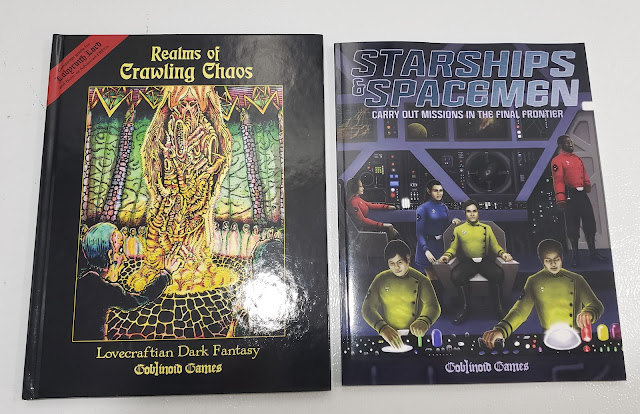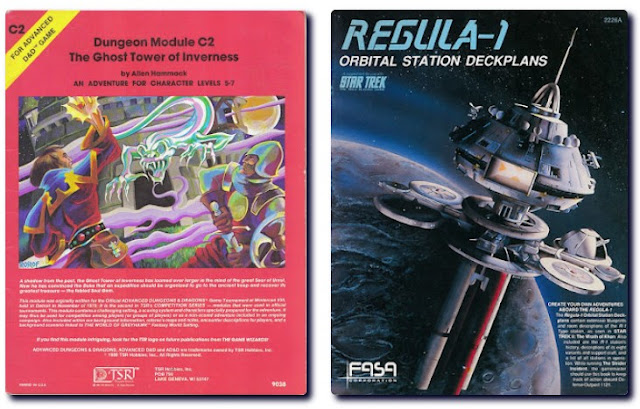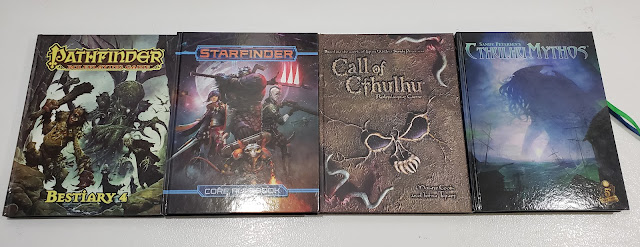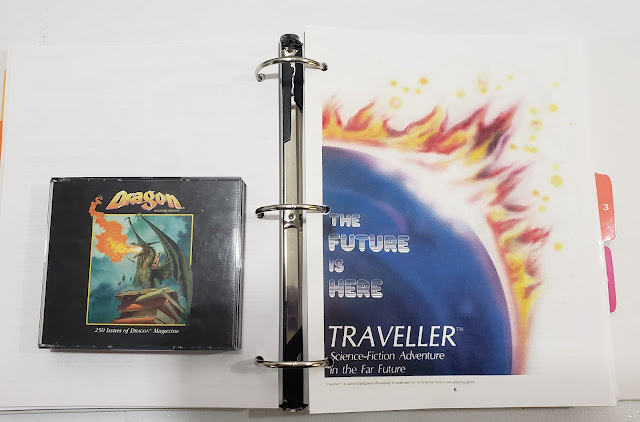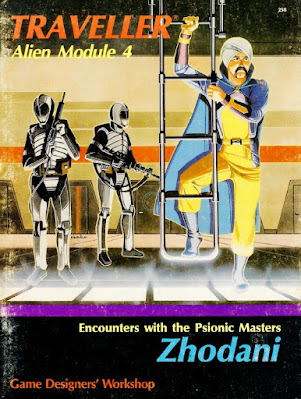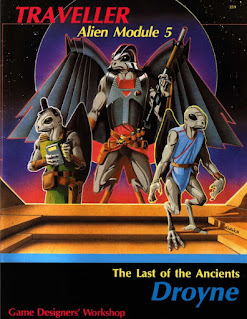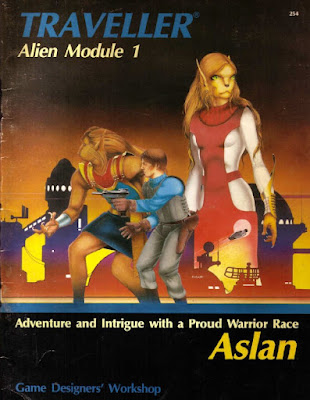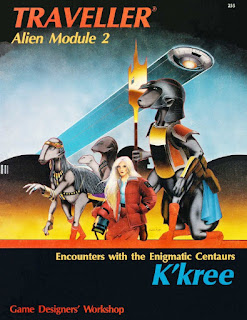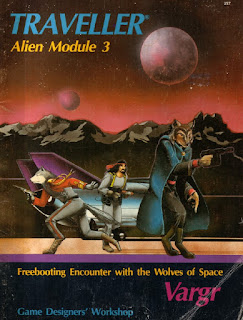"Don't stop thinking about tomorrow
Don't stop, it'll soon be here
It'll be better than before
Yesterday's gone, yesterday's gone."
Fleetwood Mac's 1977 hit "Don't Stop" came out the same year as Classic Traveller. It was also, more or less, the theme that covered the intro the 1990s. Newly elected Bill Clinton had used it as his campaign theme song and even Fleetwood Mac got back together long enough to play it at his inaugural ball in 1993. Think about the start of the 90s for a second. Everything seemed possible then. I was in Grad School, working part-time (only 60 hours a week) for the Navy writing code. I was taking classes, and teaching. I had broken up with my long-time girlfriend and soon started dating someone who would in just a few more years be my wife! So yeah the future was full of endless possibilities in 1993.
Traveller: The New Era feels like the most "1993" game ever. Tomorrow was here and Yesterday (Classic Traveller if you will) was gone.
For this review, I am only considering the PDF I just downloaded from DriveThruRPG. My original one was corrupted and I was wondering if I was even going to get to do this one today. I saw the PDF in DT was updated back 2014, so I grabbed a new one. Glad I did. I remember my first one was very hard to read and the text was blurry. This new one is much clearer. I also recall that some of the pages had a green background, this one does not.
PDF. 386 pages, color covers, black & white interior art. Oddly there are no PDF bookmarks in this file. The book is also available as a softcover PoD. I have no idea which printing this is. I understand the first printing had a few errors.
This book is a beast. I think (not 100% sure) that this was a boxed set of different books.
One of the first things I noticed about this edition is that Frank Chadwick and Dave Nilsen are listed for Game Design and Marc Millar is only listed for Design of the previous version of Traveller. I remember some of this back in the day, but for now, I am going to focus on just what is in the book.
The book is divided up into various large sections. The table of contents seems to deny my guess that this pdf was separate books at one point. Ok, no problem.
Introduction (and History)
This is our introduction to the Traveller Universe. The History section is the most important for this edition since it sets up how this is different than the previous editions. For starters, the Imperium has completely collapsed. Classic Traveller was taking place roughly around 1110 of the Imperial Calendar. MegaTraveller dealt with the aftermath of the Emperor's assassination in 1116. This Traveller jumps ahead by 85 or so years to the 1201 "The New Era." Honestly from a design/edition perspective, this makes a lot of sense.
It is a neat background and welcome (in a manner of speaking) to older players but new players likely won't care about this. The "world" of TNE is very different than that of MegaTraveller of Classic Traveller. Even at just a few pages it is still more background than we got in the LBB of Classic.
Characters
Character creation in TNE feels similar and different at the same time. You are still rolling 2d6, though now it is a 2d6-1. This changed the average from 7 to 6. There are still six attributes that are roughly the same. TNE has Strength, Agility, Constitution, Intelligence, Education, and Charisma. Classic Traveller had Strength, Dexterity, Endurance, Intelligence, Education, and Social. So similar. TNE also offers a point spread of 36 to distribute if you prefer. We are still using the UPP, only now a 666666 denotes an average character instead of 777777. Abilities are determined, then the background generation begins. Like previous versions of Traveller, you decide on a homeworld (which can affect some abilities) and work out your starting careers.
This version seems to have more careers than previous versions, but keep in mind I am only looking at core books for now. Character generation covers about 43 pages total. So quite a lot really. NPCs cover about 8 pages, with a nice playing card system to determine motivations.
The character creation rules now make no assumption of species or gender, so that is left to the player. Thre are 5 pages of alien templates to add to characters at the end of this section. There are Hivers, Vargr, Aslan, Zhodani, and Droyne.
The New Era
This covers what is, well, new for this version of Traveller's universe. These are the AI Virus, the Star Vikings, and The Wilds. I don't need to know much about Traveller or TNE to know these elements were not well received. The Virus reads like how we looked at computer viruses in the 90s. The flowchart looks like something you would find on a Mac Quadra 900 (btw I consider that a Feature, not a Bug).
I can see a smart AI virus attacking all sorts of computers, but even today we have good anti-virus software and still a couple of dozen operating systems (I count 7 or 8 different ones in my house alone) that do not transmit viruses to each other even when networked.
The Star Vikings seem like an inevitable addition to the game. The Wilds, likewise.
All of this seems like an attempt to provide a little more chaos around the "edges" of the star systems. That is, give the PCs more to do and ways to make it through or hinder them in some ways.
Referees
A little more than a quarter of the way through we hit the Referee's section. The system seems closer to that of Traveller 2300 than it does of Classic Traveller or MegaTraveller. There are now d20 rolls added to the rules. Reading through in detail now there are a lot of d20 rolls. More details are given on how to make the rolls than I recall in MT or CT.
Skills are discussed in terms of what they can do. And the Referee gets some adventure ideas. This section is only about 70 pages. I was expecting a bit more.
Worlds & Travel
Now, this is a meaty section of about 100 pages. The world generation system feels similar-ish to other Traveller games, no point reinventing everything I guess. Though there is a lot more detail here. It does look like it can create worlds much the same way as MegaTraveller.
This section also includes the Encounters and Animals sections from previous versions with some modifications. Same with space travel.
Interestingly enough the Psionics section, usually stuck into the back of the book, is now here. I still think it should be with Character creation, but ok. It is also expanded. In the realm of purely new-to-a-core-rules material, there is a sections robots. Even if it tells us there are nearly no production facilities for robots still operational outside of the Spinward Marches in the New Era.
Combat
The next nearly 100 pages deal with all forms of combat. From personal to space combat. The rules are updated and seem to cover most situations. Hard to tell without doing it. I am still thinking I need to run simulated combat for each version to see how they are. Do something silly like a Borg Cube vs the Death Star or a Colonial Viper vs an X-Wing vs. a Buck Rogers Thunderfighter.
Combat is different than other versions of Traveller.
There is some advice here too on using minis in a game. Their recommendation is to paint them all white to make them easier to see. "Step 5 Admire your Work" is something I do naturally!
Equipment & Technology
The section covers roughly 40 pages. I can't help but notice the effect that Star Trek: The Next Generation has seem to have had here. Med bays and medical scanners look like they were taken from a Federation garage sale. Ok...it's not that bad. Excuse a little levity on my part here. We still have a section on drugs.
We are keeping the same assumptions (and rules) about Technology Levels which is still hanging out at TL 16.
Computers have fared a little better in this edition. At least the batteries of the future are closer to what we have right now. I hate to harp on this, but my phone today can do nearly everything on pages 340 to 343. I am being unduly harsh here I know.
The section of Starships though once again fills my heart with longing for the stars. Many of these I am familiar with. You may not have been on the internet talking about Star Trek or starships, but I certainly was.
 |
| Flashback to when I called the ending to S2 of Picard nearly 30 years ago. |
The last few pages are worksheets for Characters, Combat charts, and the Index.
--
So. My feeling on Traveller TNE is that it was an attempt to keep Traveller moving forward.
I have gone through the TNE book more and compared them to my "Gold Standard" the Traveller Book and I am now seeing a lot more differences in terms of rules than I did on my first couple of read-throughs. This is the issue with reading a gamebook vs. playing the game. Further research outside of this book lets me know that other GDW games of the time were using the same rules. This is expected really. Game companies began to discover that using one system in-house was much cheaper in the long run. Not only did it mean you could hire fewer people to write, but you could also lift large sections of text from one game to fill in for another. This does create an issue though. There are two different writing "tones" here. I have no evidence but I am going to say the older-ish material was Frank Chadwick and the newer stuff was Dave Nilsen.
Rereading the rules prior to this post it dawned on my why I felt so much of it was familiar. It was Traveller-speak, but the rules were an old favorite of mine Dark Conspiracy. I rather liked that game back in the later 90s when I first encountered it and was looking for a new horror game to be my "home game" (spoiler, it was CJ Carrella's WitchCraft that won that battle!)
This an interesting idea though. Dark Conspiracy + Traveller The New Era would make for an interesting BlackStar-like game. I am sure I am not the only one who did that. Given the post-apoc feel of TNE I am not sure that hoards of undead would not feel so out of place, to be honest.
So we have a system that the older players don't like and newer players can't get into in a setting that the older players hate and the newer players have no investment in. Sound about right?
Still. There are some ideas here that I might mine. I am glad I have the PDF but I am not picking up the PoD anytime soon.



